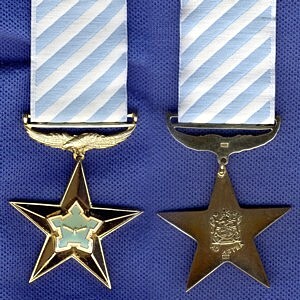Ad Astra Decoration
| Ad Astra Decoration | |
|---|---|
 |
|
| Awarded by the State President and, from 1994, the President | |
| Country |
|
| Type | Military decoration for bravery |
| Eligibility | South African Air Force aircrew |
| Awarded for | Excellent airmanship or outstanding ingenuity or skill during emergencies or critically unusual situations in the air |
| Status | Discontinued in 2003 |
| Post-nominals | AAD |
| Statistics | |
| Established | 1991 |
| First awarded | 1995 |
| SADF pre-1994 & SANDF post-2002 orders of wear | |
| Next (higher) |
SADF precedence:
SANDF precedence:
|
| Next (lower) |
SADF succession:
SANDF succession:
|
|
Ribbon bar |
|
The Ad Astra Decoration, post-nominal letters AAD, was instituted by the Republic of South Africa in 1991, to reward South African Air Force aircrew members on board aircraft for excellent airmanship or outstanding ingenuity or skill during emergencies or critically unusual situations in the air. It was discontinued in 2003, but backdated awards can still be made for acts performed during the period in effect.
The Union Defence Forces (UDF) were established in 1912 and renamed the South African Defence Force (SADF) in 1958. On 27 April 1994 it was integrated with six other independent forces into the South African National Defence Force (SANDF).
In 1952, when South Africa instituted its own military decorations and medals to replace the British honours which could, until then, be awarded to members of the UDF, equivalents of, amongst others, the British Distinguished Flying Cross (DFC) and Air Force Cross (AFC) were omitted. This omission was only belatedly addressed near the end of the 1966-1989 Border War, in 1987, when the institution of the South African Air Force Cross was proposed.
As proposed, the Air Force Cross (CA) was intended for award only to aircrew who displayed exceptional courage and leadership during dangerous or critical situations while airborne, where an award for bravery would not be suitable, based on the premise that bravery involves knowingly entering mortal danger from a position of relative safety, as opposed to skillfully reacting to an unforeseen situation of mortal danger. The proposed criteria were described in the draft warrant as excellent airmanship or outstanding ingenuity or skill during emergencies or unusual situations in the air.
When the other three Arms of the Service subsequently proposed that an Army Cross (CM), a Navy Cross (CN) and a Medical Service Cross (CC) should be instituted simultaneously, the proposed award criteria of all four crosses were amended to outstanding ingenuity or skill in the utilisation and control of personnel, weaponry or other equipment in dangerous situations and, in the case of the proposed Air Force Cross, not necessarily restricted to flying.
Since the requirement for a decoration similar to the British Distinguished Flying Cross still existed, the institution of the Ad Astra Decoration, post-nominal letters AAD, was proposed in 1991. As was originally intended with the Air Force Cross, the criteria were again described in the draft warrant as excellent airmanship or outstanding ingenuity or skill during emergencies or critically unusual situations in the air. Two of the examples which served as motivation, would without doubt have qualified the respective pilots for the award of the equivalent of a Distinguished Flying Cross, had such a decoration existed in South Africa at the time.
...
Wikipedia
